Gabapentin Enacarbil
Editor-In-Chief: C. Michael Gibson, M.S., M.D. [1]; Associate Editor(s)-in-Chief: Kiran Singh, M.D. [2]
Disclaimer
WikiDoc MAKES NO GUARANTEE OF VALIDITY. WikiDoc is not a professional health care provider, nor is it a suitable replacement for a licensed healthcare provider. WikiDoc is intended to be an educational tool, not a tool for any form of healthcare delivery. The educational content on WikiDoc drug pages is based upon the FDA package insert, National Library of Medicine content and practice guidelines / consensus statements. WikiDoc does not promote the administration of any medication or device that is not consistent with its labeling. Please read our full disclaimer here.
Overview
Gabapentin Enacarbil is a central nervous system agent that is FDA approved for the treatment of primary restless legs syndrome and postherpetic neuralgia. Common adverse reactions include somnolence, sedation dizziness, and headache.
Adult Indications and Dosage
FDA-Labeled Indications and Dosage (Adult)
Indications
Treatment of Restless Legs Syndrome
- HORIZANT® (gabapentin enacarbil) Extended-Release Tablets are indicated for the treatment of moderate-to-severe primary Restless Legs Syndrome (RLS) in adults.
HORIZANT is not recommended for patients who are required to sleep during the daytime and remain awake at night.
Management of Postherpetic Neuralgia
- HORIZANT (gabapentin enacarbil) Extended-Release Tablets are indicated for the management of postherpetic neuralgia (PHN) in adults.
Dosage
- Tablets should be swallowed whole and should not be cut, crushed, or chewed.
- Tablets should be taken with food.
- HORIZANT is not interchangeable with other gabapentin products because of differing pharmacokinetic profiles.
Restless Legs Syndrome
- The recommended dosage for HORIZANT is 600 mg once daily at about 5 PM. A daily dose of 1,200 mg provided no additional benefit compared with the 600-mg dose, but caused an increase in adverse reactions.
- If the dose is not taken at the recommended time, the next dose should be taken the following day as prescribed.
Postherpetic Neuralgia
- The recommended dosage of HORIZANT is 600 mg twice daily. HORIZANT should be initiated at a dose of 600 mg in the morning for 3 days of therapy, then increased to 600 mg twice daily (1,200 mg/day) on day four. In the 12-week principal efficacy study, additional benefit of using doses greater than 1,200 mg a day was not demonstrated, and these higher doses resulted in an increase in adverse reactions.
- If the dose is not taken at the recommended time, skip this dose, and the next dose should be taken at the time of the next scheduled dose.
Renal Impairment
- Dosing of HORIZANT is adjusted in accordance with renal function, as represented by creatinine clearance
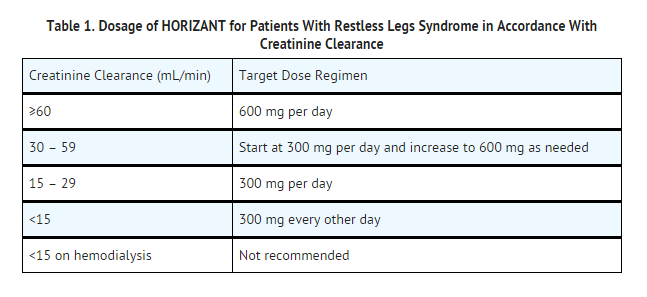
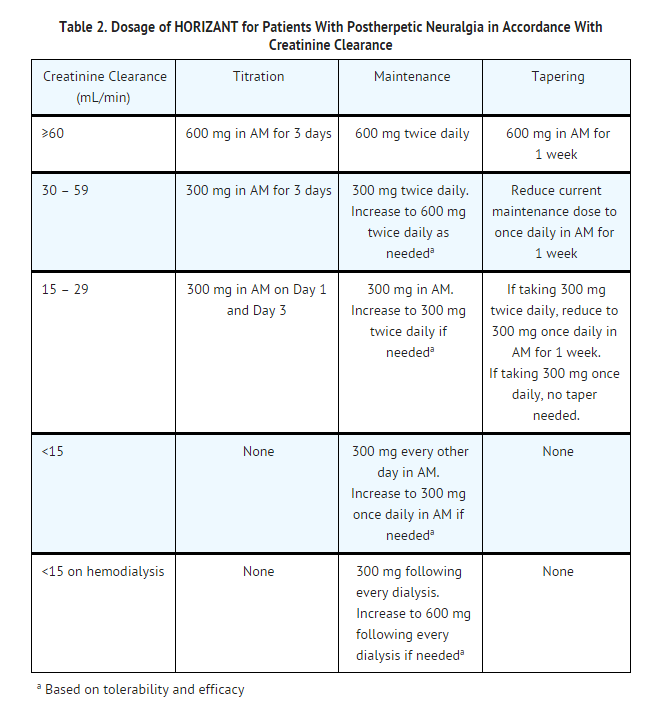
- In patients with stable renal function, CrCl can be estimated using the equation of Cockcroft and Gault:
:*for males: CrCl = (140-age)(weight)/[(72)(SCr)]
:*for females: CrCl = (0.85)(140-age)(weight)/[(72)(SCr)]
- where age is in years, weight is in kilograms, and SCr is serum creatinine in mg/dL.
DOSAGE FORMS AND STRENGTHS
- HORIZANT Extended-Release Tablets, 300 mg, are white to off-white, oval-shaped tablets debossed with “GS TF7” and 600 mg, are white to off-white, oval-shaped tablets debossed with “GS LFG”. Both the 300 mg and 600 mg tablets may contain occasional black/grey spots.
Off-Label Use and Dosage (Adult)
Guideline-Supported Use
- There is limited information regarding Off-Label Guideline-Supported Use of Gabapentin Enacarbil in adult patients.
Non–Guideline-Supported Use
- There is limited information regarding Off-Label Non–Guideline-Supported Use of Gabapentin Enacarbil in adult patients.
Pediatric Indications and Dosage
FDA-Labeled Indications and Dosage (Pediatric)
- There is limited information regarding FDA-Labeled Use of Gabapentin Enacarbil in pediatric patients.
Off-Label Use and Dosage (Pediatric)
Guideline-Supported Use
- There is limited information regarding Off-Label Guideline-Supported Use of Gabapentin Enacarbil in pediatric patients.
Non–Guideline-Supported Use
- There is limited information regarding Off-Label Non–Guideline-Supported Use of Gabapentin Enacarbil in pediatric patients.
Contraindications
- None
Warnings
Effects on Driving
- HORIZANT may cause significant driving impairment. The duration of driving impairment after starting therapy with HORIZANT is unknown. Patients taking HORIZANT should not drive until they have gained sufficient experience to assess whether HORIZANT impairs their ability to drive. However, prescribers and patients should be aware that patients’ ability to assess their own driving competence, as well as their ability to assess the degree of somnolence caused by HORIZANT, can be imperfect. Whether the impairment is related to somnolence or other effects of HORIZANT is unknown.
Somnolence/Sedation and Dizziness
- HORIZANT causes somnolence/sedation and dizziness. Patients should be advised not to drive a car or operate other complex machinery until they have gained sufficient experience on HORIZANT to assess whether HORIZANT impairs their ability to perform these tasks.
- During the controlled trials in patients with RLS, somnolence/sedation was reported in 20% of patients treated with 600 mg of HORIZANT per day compared with 6% of patients receiving placebo. In those patients treated with HORIZANT who reported somnolence, the somnolence persisted during treatment in about 30%. In the remaining patients, symptoms resolved within 3 to 4 weeks. Dizziness was reported in 13% of patients receiving 600 mg of HORIZANT per day compared with 4% of patients receiving placebo. In those patients treated with HORIZANT who reported dizziness, symptoms persisted during treatment in about 20%. Somnolence/sedation led to withdrawal in 2% of patients receiving 600 mg of HORIZANT per day. Dizziness led to withdrawal in 1% of patients receiving 600 mg of HORIZANT per day. The incidence of these adverse reactions was greater in the patients receiving 1,200 mg per day.
- During the 12-week, controlled study in patients with PHN, somnolence was reported in 10% of patients treated with 1,200 mg of HORIZANT per day compared with 8% of patients receiving placebo. Fatigue/asthenia was reported in 6% of patients treated with 1,200 mg of HORIZANT per day compared with 1% of patients receiving placebo. In those patients treated with 1,200 mg of HORIZANT per day who reported somnolence (10%), the somnolence persisted during treatment in about 27%. In the remaining patients, symptoms resolved within 4 to 5 weeks. Dizziness was reported in 17% of patients receiving 1,200 mg of HORIZANT per day compared with 15% of patients receiving placebo. In those patients treated with 1,200 mg of HORIZANT per day who reported dizziness, symptoms persisted during treatment in about 6%. Somnolence led to withdrawal in <1% of patients receiving 1,200 mg of HORIZANT per day compared with 2% of patients receiving placebo. Dizziness led to withdrawal in 2% of patients receiving 1,200 mg of HORIZANT per day compared with 3% of patients receiving placebo.
Lack of Interchangeability With Gabapentin
- HORIZANT is not interchangeable with other gabapentin products because of differing pharmacokinetic profiles. The same dose of HORIZANT results in different plasma concentrations of gabapentin relative to other gabapentin products.
- The safety and effectiveness of HORIZANT in patients with epilepsy have not been studied.
Suicidal Behavior and Ideation
- HORIZANT (gabapentin enacarbil) is a prodrug of gabapentin, an antiepileptic drug (AED). AEDs increase the risk of suicidal thoughts or behavior in patients taking these drugs for any indication. Because HORIZANT is a prodrug of gabapentin, HORIZANT also increases this risk. Patients treated with any AED for any indication should be monitored for the emergence or worsening of depression, suicidal thoughts or behavior, and/or any unusual changes in mood or behavior.
- Pooled analyses of 199 placebo-controlled clinical trials (monotherapy and adjunctive therapy) of 11 different AEDs showed that patients randomized to 1 of the AEDs had approximately twice the risk [adjusted relative risk 1.8, 95% confidence interval (CI): 1.2, 2.7] of suicidal thinking or behavior compared with patients randomized to placebo. In these trials, which had a median treatment duration of 12 weeks, the estimated incidence rate of suicidal behavior or ideation among 27,863 AED-treated patients was 0.43%, compared with 0.24% among 16,029 placebo-treated patients, representing an increase of approximately 1 case of suicidal thinking or behavior for every 530 patients treated. There were 4 suicides in drug-treated patients in the trials and none in placebo-treated patients, but the number is too small to allow any conclusion about drug effect on suicide.
- The increased risk of suicidal thoughts or behavior with AEDs was observed as early as 1 week after starting drug treatment with AEDs and persisted for the duration of treatment assessed. Because most trials included in the analysis did not extend beyond 24 weeks, the risk of suicidal thoughts or behavior beyond 24 weeks could not be assessed.
- The risk of suicidal thoughts or behavior was generally consistent among drugs in the data analyzed. The finding of increased risk with AEDs of varying mechanisms of action and across a range of indications suggests that the risk applies to all AEDs used for any indication. The risk did not vary substantially by age (5 to 100 years) in the clinical trials analyzed. Table 3 shows absolute and relative risk by indication for all evaluated AEDs.
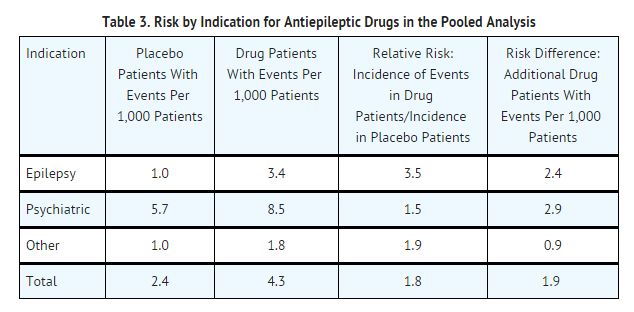
- The relative risk for suicidal thoughts or behavior was higher in clinical trials for epilepsy than in clinical trials for psychiatric or other conditions, but the absolute risk differences were similar for the epilepsy and psychiatric indications.
- Anyone considering prescribing HORIZANT must balance the risk of suicidal thoughts or behavior with the risk of untreated illness. Epilepsy and many other illnesses for which AEDs are prescribed are themselves associated with morbidity and mortality and an increased risk of suicidal thoughts and behavior. Should suicidal thoughts and behavior emerge during treatment, the prescriber needs to consider whether the emergence of these symptoms in any given patient may be related to the illness being treated.
- Patients, their caregivers, and families should be informed that HORIZANT increases the risk of suicidal thoughts and behavior and should be advised of the need to be alert for the emergence or worsening of the signs and symptoms of depression, any unusual changes in mood or behavior, or the emergence of suicidal thoughts, behavior, or thoughts about self-harm. Behaviors of concern should be reported immediately to healthcare providers.
Drug Reaction With Eosinophilia and Systemic Symptoms (DRESS)/Multiorgan Hypersensitivity
- Drug Reaction with Eosinophilia and Systemic Symptoms (DRESS), also known as multiorgan hypersensitivity, has been reported in patients taking antiepileptic drugs, including gabapentin. HORIZANT is a prodrug of gabapentin. Some of these events have been fatal or life-threatening. DRESS typically, although not exclusively, presents with fever, rash, and/or lymphadenopathy, in association with other organ system involvement, such as hepatitis, nephritis, hematological abnormalities, myocarditis, or myositis sometimes resembling an acute viral infection. Eosinophilia is often present. Because this disorder is variable in its expression, other organ systems not noted here may be involved.
- It is important to note that early manifestations of hypersensitivity, such as fever or lymphadenopathy, may be present even though rash is not evident. If such signs or symptoms are present, the patient should be evaluated immediately. HORIZANT should be discontinued if an alternative etiology for the signs or symptoms cannot be established.
Discontinuation of HORIZANT
- When discontinuing HORIZANT, patients with RLS receiving 600 mg or less once daily can discontinue the drug without tapering. If the recommended dose is exceeded, the dose should be reduced to 600 mg daily for 1 week prior to discontinuation to minimize the potential of withdrawal seizure.
- In patients with PHN receiving HORIZANT twice daily, the dose should be reduced to once daily for 1 week prior to discontinuation to minimize the potential of withdrawal seizure, see TABLE 2 [see Dosage and Administration (2.3)].
Tumorigenic Potential
- In an oral carcinogenicity study, gabapentin enacarbil increased the incidence of pancreatic acinar cell adenoma and carcinoma in male and female rats [see Nonclinical Toxicology (13.1)]. The clinical significance of this finding is unknown.
- In clinical studies of gabapentin as adjunctive therapy in epilepsy comprising 2,085 patient-years of exposure in patients >12 years of age, new tumors were reported in 10 patients (2 breast, 3 brain, 2 lung, 1 adrenal, 1 non-Hodgkin’s lymphoma, 1 endometrial carcinoma in situ), and preexisting tumors worsened in 11 patients (9 brain, 1 breast, 1 prostate) during or up to 2 years following discontinuation of gabapentin. Without knowledge of the background incidence and recurrence in a similar population not treated with gabapentin, it is impossible to know whether the incidence reported in this cohort is or is not affected by treatment.
Adverse Reactions
Clinical Trials Experience
- The following adverse reactions are described in more detail in the Warnings and Precautions section of the label:
Clinical Trials Experience
- Because clinical trials are conducted under widely varying conditions, adverse reaction rates observed in the clinical trials of a drug cannot be directly compared with rates in the clinical trials of another drug and may not reflect the rates observed in practice.
- In all controlled and uncontrolled trials across various patient populations, more than 2,300 patients have received HORIZANT orally in daily doses ranging from 600 to 3,600 mg.
- Restless Legs Syndrome: The exposure to HORIZANT in 1,201 patients with RLS included 613 exposed for at least 6 months and 371 exposed for at least 1 year. HORIZANT in the treatment of RLS was studied primarily in placebo-controlled trials (n = 642), and in long-term follow-up studies. The population with RLS ranged from 18 to 82 years of age, with 60% being female and 95% being Caucasian.
- The safety of HORIZANT in doses ranging from 600 to 2,400 mg has been evaluated in 515 patients with RLS in 3 double blind, placebo-controlled, 12 week clinical trials. The 600-mg dose was studied in 2 of the 3 studies. Eleven out of 163 (7%) patients treated with 600 mg of HORIZANT discontinued treatment due to adverse reactions compared with 10 of the 245 (4%) patients who received placebo.
- The most commonly observed adverse reactions (≥5% and at least 2 times the rate of placebo) in these trials for the 600 mg dose of HORIZANT were somnolence/sedation and dizziness. Table 4 lists treatment-emergent adverse reactions that occurred in ≥2% of patients with RLS treated with HORIZANT and numerically greater than placebo.
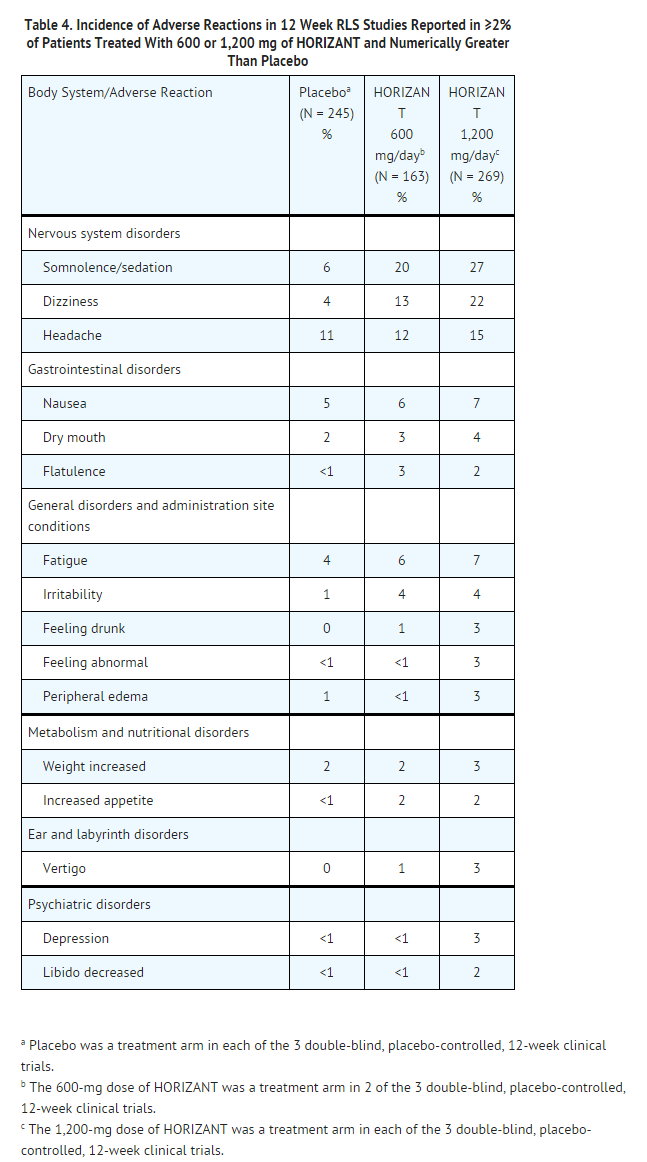
- Adverse reactions reported in these three 12 week studies in <2% of patients treated with 600 mg of HORIZANT and numerically greater than placebo were balance disorder, blurred vision, disorientation, feeling drunk, lethargy, and vertigo.
- The following adverse reactions were dose-related: somnolence/sedation, dizziness, feeling drunk, libido decreased, depression, headache, peripheral edema, and vertigo.
- Postherpetic Neuralgia: The exposure to HORIZANT in 417 patients with PHN included 207 patients exposed for at least 3 months. Overall, the mean age of patients in the PHN studies ranged from 61 to 64 years of age across dose groups; the majority of patients were male (45% to 61%) and Caucasian (80% to 98%).
- The safety of HORIZANT in doses ranging from 1,200 to 3,600 mg has been evaluated in 417 patients with PHN in 3 clinical studies. The principal efficacy study evaluating the efficacy and safety of HORIZANT in the management of PHN was a 12-week, double-blind, multicenter study comparing 1,200 mg/day, 2,400 mg/day and 3,600 mg/day to placebo. Six out of 107 (6%) patients treated with 1,200 mg of HORIZANT discontinued treatment due to adverse events compared with 12 of the 95 (13%) patients who received placebo.
- The most commonly observed adverse reactions (≥10% and greater than placebo) in this trial for the 1,200 mg dose of HORIZANT were dizziness, somnolence, and headache. Table 5 lists treatment-emergent adverse reactions that occurred in ≥2% of patients with PHN treated with HORIZANT 1,200 mg/day and numerically greater than placebo.
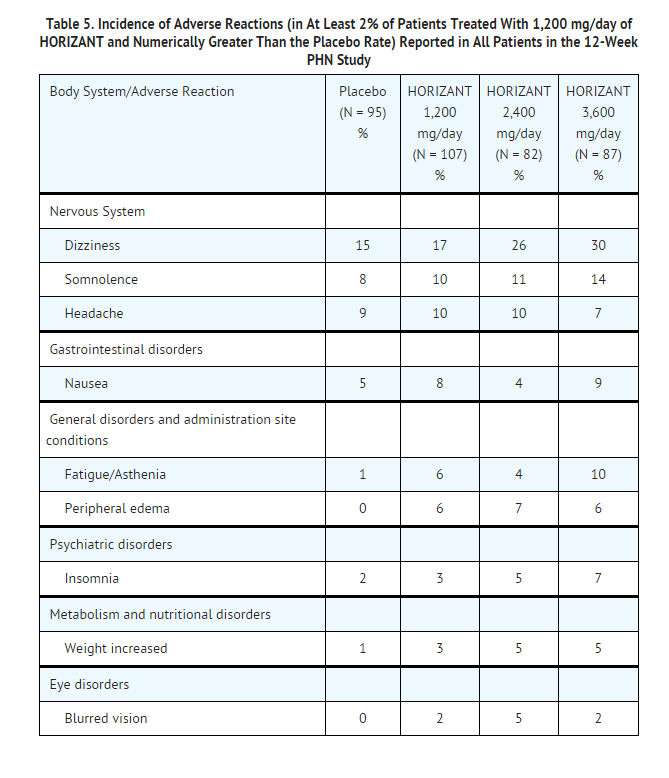
- The following adverse reactions were also reported as ≥2% at 2,400 mg/day and/or 3,600 mg/day and appeared to be dose-related but were <2% at 1,200 mg/day: balance disorder, confusional state, depression, dry mouth, flatulence, increased appetite, irritability, and vertigo. Dizziness, somnolence, fatigue, and insomnia appeared to show a dose relationship.
Adverse Events Associated With Gabapentin
- The following adverse events have been reported in patients receiving gabapentin, either in clinical trials or postmarketing: breast enlargement, gynecomastia, and elevated creatine kinase.
Postmarketing Experience
- There is limited information regarding Postmarketing Experience of Gabapentin Enacarbil in the drug label.
Drug Interactions
- Gabapentin enacarbil is released faster from HORIZANT Extended-Release tablets in the presence of alcohol. Consumption of alcohol is not recommended when taking HORIZANT
- Morphine: HORIZANT taken in conjunction with morphine causes increased somnolence/sedation, dizziness, and nausea when compared with either drug alone.
Use in Specific Populations
Pregnancy
- Pregnancy Category C. There are no adequate and well controlled studies with HORIZANT in pregnant women. In nonclinical studies in rat and rabbits, administration of gabapentin enacarbil was developmentally toxic when administered to pregnant animals at doses and gabapentin exposures greater than those used clinically. HORIZANT should be used during pregnancy only if the potential benefit justifies the potential risk to the fetus.
- When pregnant rats were administered gabapentin enacarbil (oral doses of 200, 1,000, or 5,000 mg/kg/day) throughout the period of organogenesis, embryo-fetal mortality was increased at the 2 highest doses and fetal body weights were decreased at the high dose. The no-effect dose for embryo-fetal developmental toxicity in rats (200 mg/kg/day) represents approximately 2 times the gabapentin exposure associated with the maximum recommended human dose (MRHD) of 1,200 mg/day gabapentin enacarbil on an area under the curve (AUC) basis.
- When pregnant rabbits were administered gabapentin enacarbil (oral doses of 200, 500, or 2,500 mg/kg/day) throughout the period of organogenesis, embryo-fetal mortality was increased and fetal body weights were decreased at the high dose. The no-effect dose for embryo-fetal developmental toxicity in rabbits (500 mg/kg/day) represents approximately 9 times the gabapentin exposure associated with the MRHD of 1,200 mg/day gabapentin enacarbil on an AUC basis.
- When female rats were administered gabapentin enacarbil (oral doses of 200, 1,000, or 5,000 mg/kg/day) throughout the pregnancy and lactation periods, offspring growth and survival were decreased at the two highest doses. The no-effect dose for pre- and post-natal developmental toxicity in rats is approximately 2 times the MRHD on an AUC basis.
- In reproductive and developmental studies of gabapentin, developmental toxicity was observed at all doses tested. Increased incidences of hydroureter and/or hydronephrosis were observed in rat offspring following treatment of pregnant animals in studies of fertility and general reproductive performance, embryo-fetal development, and peri- and post-natal development. Overall, a no-effect dose was not established. In mice, treatment of pregnant animals with gabapentin during the period of organogenesis resulted in delayed fetal skeletal ossification at all but the lowest dose tested. When pregnant rabbits were treated with gabapentin during the period of organogenesis, an increase in embryo-fetal mortality was observed at all doses of gabapentin tested.
- In a published study, gabapentin (400 mg/kg/day) was administered by intraperitoneal injection to neonatal mice during the first postnatal week, a period of synaptogenesis in rodents (corresponding to the last trimester of pregnancy in humans). Gabapentin caused a marked decrease in neuronal synapse formation in brains of intact mice and abnormal neuronal synapse formation in a mouse model of synaptic repair. Gabapentin has been shown in vitro to interfere with activity of the α2δ subunit of voltage-activated calcium channels, a receptor involved in neuronal synaptogenesis. The clinical significance of these findings is unknown.
- There is no Australian Drug Evaluation Committee (ADEC) guidance on usage of Gabapentin Enacarbil in women who are pregnant.
Labor and Delivery
- The effect of HORIZANT on labor and delivery is unknown.
Nursing Mothers
- It is not known whether gabapentin derived from HORIZANT is secreted in human milk; however, gabapentin is secreted into human milk following oral administration of gabapentin products. Because of the potential for adverse reactions in nursing infants from HORIZANT, a decision should be made whether to discontinue nursing or to discontinue the drug, taking into account the importance of the drug to the mother.
Pediatric Use
- Safety and effectiveness of HORIZANT in pediatric patients have not been studied.
Geriatic Use
- Of the 515 patients treated with HORIZANT in the 3 double blind, placebo controlled, 12 week clinical trials for RLS, 11% were 65 to 74 years of age and 1% were 75 years of age and older. Clinical trials of HORIZANT for the treatment of RLS did not include a sufficient number of patients 65 years and older to determine whether they respond differently from younger individuals.
- In the 12-week, double-blind, placebo-controlled study of HORIZANT for the management of PHN (n = 276 patients treated with HORIZANT), 37% were 65 to 74 years of age and 13% were 75 years of age and older. The overall incidence of adverse events was comparable between the patients aged ≥18 to <65 years and ≥65 to <74 years. No overall differences in the safety and effectiveness were observed between these subjects and younger subjects, and other reported clinical experience has not identified differences in responses between the elderly and younger patients, but greater sensitivity of some older individuals cannot be ruled out.
- Gabapentin is known to be almost exclusively excreted by the kidney, and the risk of adverse reactions to this drug may be greater in patients with impaired renal function. Because elderly patients are more likely to have decreased renal function, the frequency of dosing may need to be adjusted based on calculated creatinine clearance in these patients.
Gender
- There is no FDA guidance on the use of Gabapentin Enacarbil with respect to specific gender populations.
Race
- There is no FDA guidance on the use of Gabapentin Enacarbil with respect to specific racial populations.
Renal Impairment
- The dose of HORIZANT should be adjusted in patients with renal impairment.
Hepatic Impairment
There is no FDA guidance on the use of Gabapentin Enacarbil in patients with hepatic impairment.
Females of Reproductive Potential and Males
There is no FDA guidance on the use of Gabapentin Enacarbil in women of reproductive potentials and males.
Immunocompromised Patients
There is no FDA guidance one the use of Gabapentin Enacarbil in patients who are immunocompromised.
Administration and Monitoring
Administration
- Oral
Monitoring
There is limited information regarding Monitoring of Gabapentin Enacarbil in the drug label.
IV Compatibility
- There is limited information regarding IV Compatibility of Gabapentin Enacarbil in the drug label.
Overdosage
Human Overdose Experience
- There have been no reports describing individuals who have taken an overdose of HORIZANT. The highest single dose of gabapentin enacarbil administered to date is 6,000 mg in healthy subjects. At this supratherapeutic dose there were no serious adverse events. The incidence of central nervous system adverse reactions, particularly dizziness and somnolence/sedation, is increased with doses greater than 600 mg daily.
Overdosage Management
- In the event of an overdose, the patient should be treated supportively with appropriate monitoring as necessary. Gabapentin derived from gabapentin enacarbil can be removed from plasma by hemodialysis. The mean percentage of gabapentin recovered following hemodialysis in patients with end stage renal disease was 29% (expressed as a proportion of the gabapentin released from HORIZANT).
- Further management should be as clinically indicated or as recommended by a poison control center.
Pharmacology
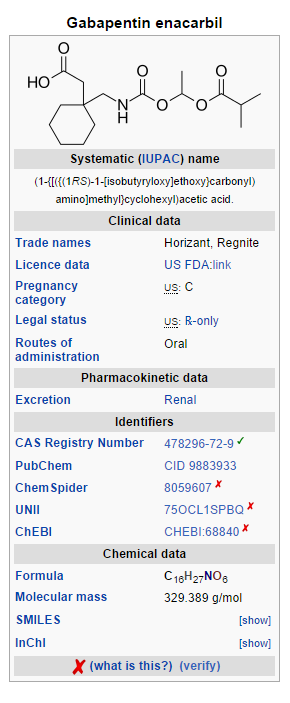
Mechanism of Action
- Gabapentin enacarbil is a prodrug of gabapentin and, accordingly, its therapeutic effects in RLS and PHN are attributable to gabapentin.
- The precise mechanism by which gabapentin is efficacious in RLS and PHN is unknown.
- The mechanism of action by which gabapentin is efficacious in PHN is unknown but in animal models of analgesia, gabapentin prevents allodynia (pain-related behavior in response to a normally innocuous stimulus) and hyperalgesia (exaggerated response to painful stimuli). Gabapentin prevents pain-related responses in several models of neuropathic pain in rats and mice (e.g., spinal nerve ligation models, spinal cord injury model, acute herpes zoster infection model). Gabapentin also decreases pain-related responses after peripheral inflammation (carrageenan footpad test, late phase of formalin test), but does not alter immediate pain-related behaviors (rat tail flick test, formalin footpad acute phase). The relevance of these models to human pain is not known.
- Gabapentin is structurally related to the neurotransmitter gamma aminobutyric acid (GABA) but has no effect on GABA binding, uptake, or degradation. Gabapentin enacarbil and gabapentin have been tested in radioligand binding assays, and neither exhibited affinity for a number of other common receptor, ion channel, or transporter proteins.
- In vitro studies have shown that gabapentin binds with high affinity to the α2δ subunit of voltage activated calcium channels; however, the relationship of this binding to the therapeutic effects of gabapentin enacarbil in RLS and PHN is unknown.
Structure
There is limited information regarding Gabapentin Enacarbil Structure in the drug label.
Pharmacodynamics
- There is limited information regarding Pharmacodynamics of Gabapentin Enacarbil in the drug label.
Pharmacokinetics
- HORIZANT is an extended-release formulation of gabapentin enacarbil, a prodrug of gabapentin. HORIZANT provides approximately dose-proportional and extended exposure to gabapentin over the range 300 to 6,000 mg. HORIZANT and gabapentin are not interchangeable because the same daily dose of each results in different plasma concentrations of gabapentin.
- For subjects with PHN taking HORIZANT 600 mg twice daily, the estimated steady state mean Cmax was 5.35 µg/mL, mean AUC24 was approximately 109 µg*hr/mL, mean Cmin was 3.63 µg/mL, and mean peak trough ratio was 1.5.
- Absorption: The pathway for absorption of gabapentin enacarbil is believed to include active transport via a proton-linked monocarboxylate transporter, MCT-1. This transporter is expressed at high levels in the intestinal tract and is not saturated by administration of high doses of HORIZANT. Mean bioavailability of gabapentin (based on urinary recovery of gabapentin) for HORIZANT in the fed state is about 75%. Bioavailability under fasting conditions has been estimated by gabapentin urinary recovery to be 42% to 65%. In a food effect study, the exposure of gabapentin increased by 24%, 34%, and 44% with low, moderate, and high fat meals, respectively. The Tmax of gabapentin after administration of 600 mg of HORIZANT was 5.0 hours in fasted subjects and 7.3 hours in fed subjects. Steady state is reached in 2 days with daily administration.
- Distribution: Plasma protein binding of gabapentin has been reported to be <3%. The apparent volume of distribution of gabapentin in subjects receiving HORIZANT is 76 L.
- Metabolism: After oral administration, gabapentin enacarbil undergoes extensive first-pass hydrolysis by non specific carboxylesterases primarily in enterocytes and to a lesser extent in the liver, to form gabapentin, carbon dioxide, acetaldehyde, and isobutyric acid. Levels of gabapentin enacarbil in blood are low and transient (≤2% of corresponding gabapentin plasma levels). Released gabapentin is not appreciably metabolized in humans. Neither gabapentin enacarbil nor gabapentin are substrates, inhibitors, or inducers of the major cytochrome P450 enzymes (CYP1A2, CYP2A6, CYP2B6, CYP2C8, CYP2C9, CYP2C19, CYP2D6, CYP2E1, and CYP3A4). Gabapentin enacarbil is neither a substrate nor an inhibitor of P-glycoprotein in vitro.
- Elimination: Following hydrolysis of gabapentin enacarbil, the released gabapentin is excreted unchanged by the kidney. Gabapentin renal excretion is believed to involve a component of active secretion via an organic cation transporter (OCT2) present in the kidney. In a human pharmacokinetic study with immediate release 14C gabapentin enacarbil, mean recovery of total radioactivity in urine was 94%, with 5% of the radioactive dose recovered in feces.
- Apparent oral clearance (CL/F) of gabapentin from plasma after dosing of HORIZANT with food ranged from 6.0 to 9.3 L/hr. Following oral dosing of HORIZANT, plasma clearance of gabapentin is approximately proportional to creatinine clearance. Renal clearance (CLr) of gabapentin ranged from 5 to 7 L/hr, regardless of food intake or food type. The elimination half life (t½) of gabapentin ranges from 5.1 to 6.0 hours and is unaltered by dose or following multiple doses of HORIZANT.
- Special Populations: Race: In the population pharmacokinetic study, the majority (94%) of subjects in the clinical studies was Caucasian, and no single other race was greater than 4%; therefore, the effect of race could not be studied.
- Gender: There are no clinically meaningful differences in pharmacokinetics of HORIZANT between male and female patients.
- Geriatric Patients: There are no clinically significant differences in pharmacokinetics of HORIZANT between geriatric patients (≥65 years of age) and younger patients (18 to <65 years of age). However, the pharmacokinetics in geriatric patients may be affected by an age-related decline in renal function.
- Renal Impairment: Gabapentin clearance after dosing with HORIZANT is approximately proportional to CrCl. Apparent oral clearance (CL/F) decreased in moderate (4.2 L/hr) and severe renal impairment patients (1.7 L/hr) compared with 6.0 to 9.3 L/hr in patients without renal impairment. Similarly, CLr was decreased to 3 and 1 L/hr in moderate and severe renal impairment patients, respectively, compared with 5 to 7 L/hr in non-renal impairment patients. Dosage reduction in patients with renal dysfunction not on dialysis is necessary.
- Gabapentin is effectively removed from plasma by hemodialysis. The mean percentage of gabapentin recovered following hemodialysis in patients with end stage renal disease was 29% (expressed as a proportion of the gabapentin released from HORIZANT). For patients with PHN on hemodialysis, dosage reduction is required [see Dosage and Administration (2.3)]. For patients with RLS on hemodialysis, treatment with HORIZANT is not recommended.
- Drug Interactions: Neither gabapentin enacarbil nor gabapentin are substrates, inhibitors, or inducers of the major cytochrome P450 enzymes. Gabapentin enacarbil is neither a substrate or an inhibitor of P-glycoprotein in vitro.
- Pharmacokinetic drug-drug interaction studies were conducted to examine the potential for an interaction of gabapentin enacarbil with cimetidine and naproxen. No significant pharmacokinetic interactions were observed. No clinically relevant pharmacokinetic interactions are expected between HORIZANT and other substrates of organic cation transporter type 2 (OCT2) and monocarboxylate transporter type 1 (MCT-1).
- Ethanol: An in vitro dissolution study was conducted to evaluate the impact of ethanol (5, 10, 20, and 40%), on the extended-release characteristics of HORIZANT. The in vitro study showed that about 63% of the total gabapentin enacarbil dose was released at 1 hour at the highest alcohol level (40%), and about 43% of total drug was released at 1 hour with 5% alcohol. Ethanol causes a more rapid release of gabapentin enacarbil from the extended-release tablets that may increase the risk for adverse events associated with HORIZANT. Consumption of alcohol is not recommended when taking HORIZANT.
- Cimetidine: Gabapentin released from HORIZANT is eliminated by renal clearance via OCT2. Cimetidine is a known substrate for this same elimination pathway. Coadministration of 1,200 mg of HORIZANT once daily with cimetidine 400 mg 4 times daily showed no effect on cimetidine exposure. There was an increase in AUC of gabapentin (24%) and a decrease in renal clearance of gabapentin (20%); these effects are not expected to be clinically relevant. No clinically relevant pharmacokinetic interactions are expected between HORIZANT and other substrates of OCT2.
- Naproxen: The pathway for absorption of gabapentin enacarbil includes active transport via a proton-linked MCT-1. Coadministration of 1,200 mg of HORIZANT once daily with naproxen 500 mg twice daily, a known substrate of MCT-1, showed no effect on naproxen exposure or steady-state gabapentin Cmax and AUC. No clinically relevant pharmacokinetic interactions are expected between HORIZANT and other substrates of MCT-1.
- Morphine: Administration of a single 600-mg dose of HORIZANT 2 hours after a single 60-mg dose of extended-release morphine sulfate in 18 subjects was associated with increased somnolence/sedation, dizziness, and nausea for the combination compared to HORIZANT or morphine alone as measured by the visual analog scale. No changes in Cmax and AUC of gabapentin, morphine or its active metabolite morphine-6-glucuronide were observed.
Cardiac Electrophysiology
- At a dose of 6,000 mg, gabapentin enacarbil does not prolong QTc to a clinically relevant extent.
Nonclinical Toxicology
Carcinogenesis, Mutagenesis, Impairment of Fertility
- Carcinogenesis: Oral (gavage) carcinogenicity studies were conducted in mice and rats. In mice, gabapentin enacarbil was tested at doses of 500, 2,000, or 5,000 mg/kg/day for up to 104 weeks. There was no evidence of drug-related carcinogenicity. The highest dose tested is 16 times the MRHD of 1,200 mg/day, on a plasma AUC basis.
- In rats, gabapentin enacarbil was tested at doses of 500, 2,000, or 5,000 mg/kg/day for up to 97 weeks in mid-dose males, 90 weeks in high-dose males, and 104 weeks in females. The plasma exposures (AUC) for gabapentin at these doses are approximately 4, 17, and 37 times, respectively, that in humans at the MRHD. Increases in the incidence of pancreatic acinar adenoma and carcinoma were found in mid-dose males and high-dose males and females.
- In 2-year dietary carcinogenicity studies of gabapentin, no evidence of drug-related carcinogenicity was observed in mice treated at doses up to 2,000 mg/kg/day. In rats, increases in the incidence of pancreatic acinar cell adenoma and carcinoma were found in male rats receiving the highest dose (2,000 mg/kg), but not at doses of 250 or 1,000 mg/kg/day. At 1,000 mg/kg/day, the plasma AUC for gabapentin is estimated to be approximately 13 times that in humans at the MRHD.
- Studies designed to investigate the mechanism of gabapentin-induced pancreatic carcinogenesis in rats indicate that gabapentin stimulates DNA synthesis in rat pancreatic acinar cells in vitro and thus may be acting as a tumor promoter by enhancing mitogenic activity. It is not known whether gabapentin has the ability to increase cell proliferation in other cell types or in other species, including human.
- Mutagenesis: Gabapentin enacarbil was negative in in vitro bacterial reverse mutation (Ames) and in vivo rat micronucleus assays. In an in vitro human lymphocyte assay, there was an increase in the number of chromosomal aberrations with gabapentin enacarbil. This in vitro response was attributed to acetaldehyde released by hydrolysis of gabapentin enacarbil during the incubation period. Acetaldehyde is known to cause chromosome aberrations in vitro, but is readily metabolized in vivo. The small quantity of acetaldehyde formed from gabapentin enacarbil in vivo is rapidly cleared by normal metabolic activity.
- Impairment of Fertility: Oral administration of gabapentin enacarbil (doses of 0, 200, 1,000, or 5,000 mg/kg/day) to male and female rats prior to and throughout mating and continuing in females up to day 7 of gestation resulted in no adverse effects on fertility. The highest dose tested is approximately 39 times the MRHD on an AUC basis.
Clinical Studies
Restless Legs Syndrome (RLS) 12 Week Pivotal Studies
- The effectiveness of HORIZANT in the treatment of moderate-to-severe primary RLS was demonstrated in two 12-week clinical studies in adults diagnosed with RLS using the International Restless Legs Syndrome Study Group diagnostic criteria. Key diagnostic criteria for RLS are: an urge to move the legs usually accompanied or caused by uncomfortable and unpleasant leg sensations, symptoms begin or worsen during periods of rest or inactivity such as lying or sitting, symptoms are partially or totally relieved by movement such as walking or stretching at least as long as the activity continues, and symptoms are worse or occur only in the evening or night. Patients were required to have a total score of ≥15 on the International Restless Legs Syndrome (IRLS) Rating Scale at baseline. Patients with RLS secondary to other conditions (e.g., pregnancy, renal failure, iron deficiency anemia) were excluded. In study 1, patients were randomized to receive 1,200 mg of HORIZANT (N = 112) or placebo (N = 108) taken once daily at about 5 PM with food. In study 2, patients were randomized to receive 600 mg of HORIZANT (N = 114), 1,200 mg of HORIZANT (N = 111), or placebo (N = 96) taken once daily at about 5 PM with food.
- Efficacy was evaluated using the IRLS Rating Scale and Clinical Global Impression of Improvement (CGI-I) scores. The IRLS Rating Scale contains 10 items designed to assess the severity of sensory and motor symptoms, sleep disturbance, daytime somnolence/sedation, and impact on activities of daily living and mood associated with RLS. The range of scores is 0 to 40, with 0 being absence of RLS symptoms and 40 the most severe symptoms. The CGI-I Scale allows the investigator to rate the patients overall change in RLS symptoms since baseline, whether or not in the opinion of the investigator the change is related to study drug treatment. The change from baseline in the IRLS Rating Scale at Week 12 and the proportion of responders on the CGI-I Scale defined as a rating of "much improved" or "very much improved" at Week 12 were co-primary outcomes in these studies.
- In these 2 studies, the mean age of patients studied was 50 years (range: 18 to 81 years); 59% of the patients were female. The racial distribution for these studies was as follows: Caucasian, 95%; black, 2%; and other, 3%.
- Statistically significant differences (P<0.05) between the treatment groups receiving 600 and 1,200 mg of HORIZANT and the group receiving placebo were observed at Week 12 for both the mean change from baseline in the IRLS Scale total score and the proportion of responders ("much improved" or "very much improved") on the CGI-I Scale as described in TABLE 6.

- Figure 1 presents the improvement in mean IRLS Rating Scale total score in patients treated with placebo or 600 or 1,200 mg of HORIZANT over the 12 weeks of treatment in study 2.
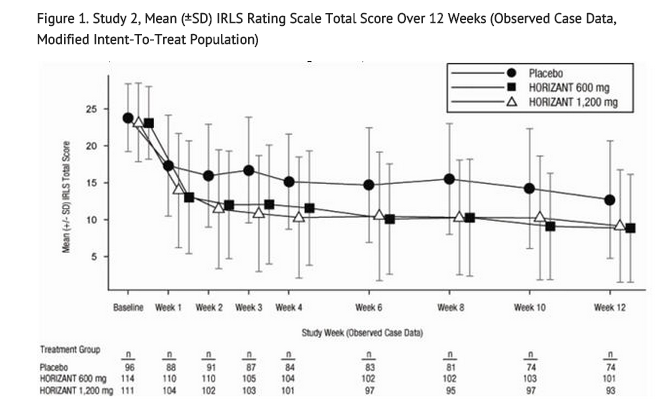
Postherpetic Neuralgia (PHN) 12 Week Study
- The efficacy of HORIZANT for the management of postherpetic neuralgia was established in a multicenter, randomized, double-blind, parallel-group, placebo-controlled, 12-week study evaluating the efficacy, safety, and dose response of 3 maintenance doses of HORIZANT (1,200, 2,400, and 3,600 mg/day, with 107, 82, and 87 patients in each dosing group, respectively). Patients greater than 18 years of age with a documented medical diagnosis of PHN of at least three months duration were enrolled. To ensure that patients had significant pain, randomized patients were required to have a minimum baseline 24-hour average Pain Intensity Numerical Rating Scale (PI-NRS) intensity score of at least 4.0 on the 11-point numerical PI-NRS, ranging from 0 (“no pain”) to 10 (“pain as bad as you can imagine”).
- In this study, a total of 276 patients received HORIZANT while 95 patients received placebo. Following a 1-week baseline period during which patients were screened for eligibility, patients began a 1-week up-titration period followed by a 12-week maintenance treatment period, and then a 1-week down-titration period.
- Treatment with HORIZANT statistically significantly improved the mean pain score and increased the proportion of patients with at least a 50% reduction in pain score from baseline at all doses tested. A benefit over placebo was observed for all 3 doses of HORIZANT as early as Week 1 and maintained to the end of treatment. Additional benefit of using doses of greater than 1,200 mg a day was not demonstrated.
- For various degrees of improvement in pain from baseline to end of maintenance treatment, Figure 2 shows the fraction of patients achieving that degree of improvement. The figure is cumulative, so that patients whose change from baseline is, for example, 50%, are also included at every level of improvement below 50%. Patients who did not complete the study were assigned 0% improvement.
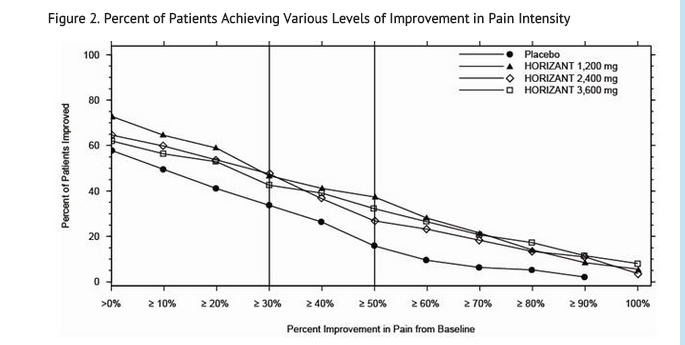
Effects on Driving
- Driving performance was assessed in a three way crossover study in healthy volunteers (mean age 36 years). Subjects were dosed at approximately 5 pm with HORIZANT 600 mg (for five days), diphenhydramine 50 mg (1 dose), and placebo (for five days). After the last dose, driving was evaluated on a computer-based simulation for 1 hour in the evening approximately 2 to 4 hours after dosing (7 to 9 pm), in the morning after dosing (7 to 9 am), and at midday the day after dosing (11 am to 1 pm). The primary endpoint of the study was lane position variability. There was no difference in change from baseline in lane position variability for HORIZANT compared to placebo at any of the simulated driving timepoints. Secondary measures included speed variability and the occurrence of simulated crashes. Subjects in this study experienced simulated crashes as described in TABLE 7. At the times that simulated crashes occurred, there was an increase in average speed variability in the HORIZANT and diphenhydramine treated groups that was most notable in patients who experienced simulated crashes, but no increases in lane position variability. Later time points post-dosing or the effects of driving after more than five days of dosing with HORIZANT were not evaluated.
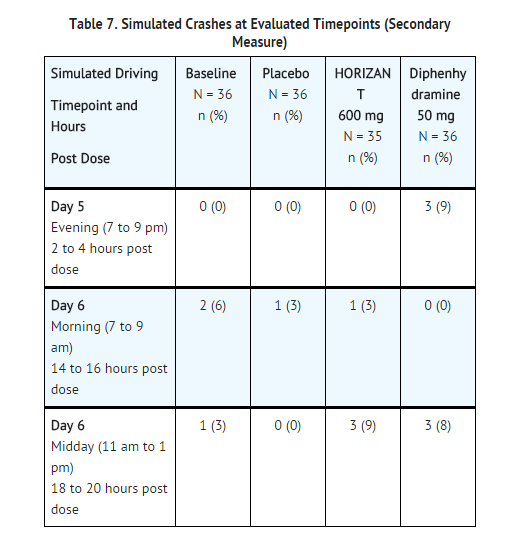
- The results of a separate 2-week driving simulation study in patients (mean age 47 years) with moderate-to-severe primary RLS showed that once daily doses of 1,200 mg and 1,800 mg of HORIZANT significantly impaired simulated driving performance based on lane position variability. An increased number of simulated crashes were reported in patients tested near Tmax after receiving 1,200 mg or 1,800 mg of HORIZANT compared to patients treated with diphenhydramine 50 mg. In addition, patients receiving 1,200 mg of HORIZANT experienced an increased number of simulated crashes at 14 to 16 hours after dosing compared with placebo, diphenhydramine, and 1,800 mg of HORIZANT.
- The design limitations of these two studies do not permit inference regarding dose response relationship or the duration of the effect HORIZANT has on driving in patients with RLS.
- The results of a separate driving simulation study comparing untreated RLS patients and healthy subjects showed no difference in lane position variability but an increase in speed variability associated with a greater number of simulated crashes in RLS patients relative to healthy subjects, which may indicate impaired driving in RLS patients in the absence of medication.
How Supplied
- HORIZANT Extended-Release Tablets containing 300 mg of gabapentin enacarbil are white to off-white, with occasional black/grey spots, oval-shaped tablets debossed with "GS TF7".
- HORIZANT Extended-Release Tablets containing 600 mg of gabapentin enacarbil are white to off-white, with occasional black/grey spots, oval-shaped tablets debossed with "GS LFG". They are supplied as follows:
- 300 mg: NDC 53451-0103-1: Bottles of 30
- 600 mg: NDC 53451-0101-1: Bottles of 30
Storage
- Store at 25°C (77°F); excursions permitted 15° to 30°C (59° to 86°F) [see USP Controlled Room Temperature]. Protect from moisture. Do not remove desiccants.
Images
Drug Images
{{#ask: Page Name::Gabapentin Enacarbil |?Pill Name |?Drug Name |?Pill Ingred |?Pill Imprint |?Pill Dosage |?Pill Color |?Pill Shape |?Pill Size (mm) |?Pill Scoring |?NDC |?Drug Author |format=template |template=DrugPageImages |mainlabel=- |sort=Pill Name }}
Package and Label Display Panel

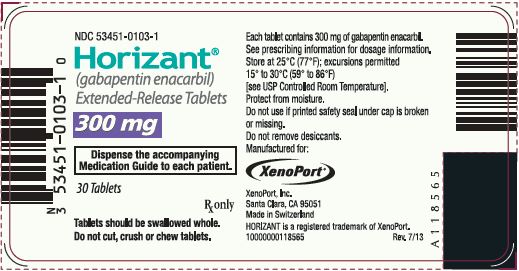
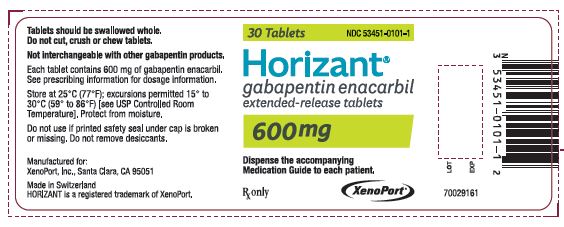
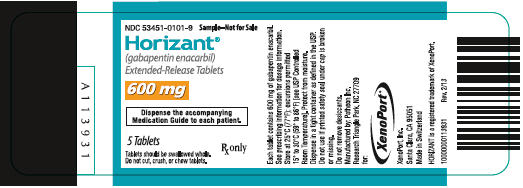

{{#ask: Label Page::Gabapentin Enacarbil |?Label Name |format=template |template=DrugLabelImages |mainlabel=- |sort=Label Page }}
Patient Counseling Information
- Physicians should instruct their patients to read the Medication Guide before starting therapy with HORIZANT and to reread it upon prescription renewal for new information regarding the use of HORIZANT.
Effects on Driving
- Patients should be told that HORIZANT may cause a significant driving impairment. Accordingly, they should be advised not to drive a car until they have gained sufficient experience on HORIZANT to assess whether HORIZANT impairs their ability to drive, although patients’ ability to determine their level of impairment can be unreliable. Patients should be told that it is not known how long this effect lasts.
Somnolence/Sedation and Dizziness
- Patients should be told that HORIZANT can cause significant somnolence and dizziness. This typically resolves within several weeks of initiating treatment. Accordingly, they should be told not to operate dangerous machinery until they have gained sufficient experience on HORIZANT to assess whether HORIZANT impairs their ability to operate dangerous machinery safely.
Suicidal Behavior and Ideation
- Patients, their caregivers, and families should be counseled that HORIZANT may increase the risk of suicidal thoughts and behavior, and should be advised of the need to be alert for the emergence or worsening of symptoms of depression, any unusual changes in mood or behavior, or the emergence of suicidal thoughts, behavior, or thoughts about self-harm. Behaviors of concern should be reported immediately to healthcare providers.
Drug Reaction With Eosinophilia and Systemic Symptoms(DRESS)/Multiorgan Hypersensitivity
- Patients should be instructed that multiorgan hypersensitivity reactions may occur with HORIZANT. Patients should contact their physician immediately if they experience any signs or symptoms of these conditions [see Warnings and Precautions (5.5)].
Lack of Interchangeability With Gabapentin
- Patients should be advised that doses of HORIZANT and other gabapentin products are not interchangeable.
Dosing Instructions
- Instruct patients to take HORIZANT only as prescribed.
- Instruct patients to swallow tablets whole and do not cut, crush, or chew tablets.
- Instruct patients to take HORIZANT with food.
- For Restless Legs Syndrome, 600 mg HORIZANT should be taken once daily at about 5 PM. If the dose is not taken at the recommended time, the patient should take the next dose at about 5 PM the following day.
- For Postherpetic Neuralgia, the starting dose is 600 mg HORIZANT in the morning for 3 days. Starting on day 4, 600 mg HORIZANT should be taken twice daily. If the dose is not taken at the recommended time, the next dose should be taken at the time of next scheduled dose.
- Instruct patients about how to discontinue HORIZANT.
Alcohol
- Advise patients to avoid alcohol when taking HORIZANT.
Precautions with Alcohol
- Alcohol-Gabapentin Enacarbil interaction has not been established. Talk to your doctor about the effects of taking alcohol with this medication.
Brand Names
- HORIZANT ®[1]
Look-Alike Drug Names
There is limited information regarding Gabapentin Enacarbil Look-Alike Drug Names in the drug label.
Drug Shortage Status
Price
References
The contents of this FDA label are provided by the National Library of Medicine.
{{#subobject:
|Page Name=Gabapentin Enacarbil
|Pill Name=No image.jpg
|Drug Name=
|Pill Ingred=|+sep=;
|Pill Imprint=
|Pill Dosage={{{dosageValue}}} {{{dosageUnit}}}
|Pill Color=|+sep=;
|Pill Shape=
|Pill Size (mm)=
|Pill Scoring=
|Pill Image=
|Drug Author=
|NDC=
}}
{{#subobject:
|Label Page=Gabapentin Enacarbil |Label Name=Gabapentin Enacarbil11.png
}}
{{#subobject:
|Label Page=Gabapentin Enacarbil |Label Name=Gabapentin Enacarbil11.png
}}